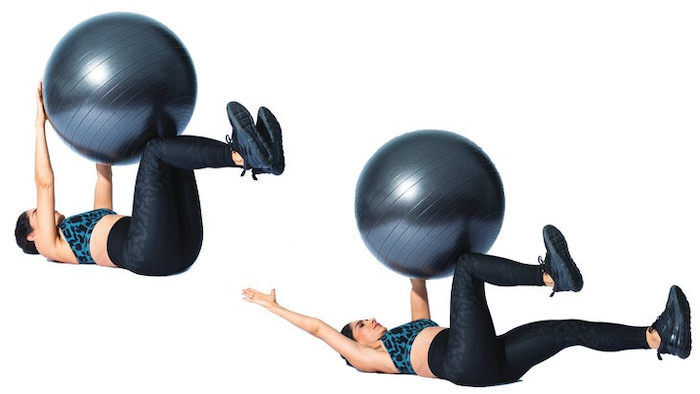
These back exercises using exercise balls are designed to strengthen the muscles that support the spine from the lower back to the upper back, in front and back. Specific muscles targeted by these exercises include the abdominal, chest, and back muscles.
These core body strength exercises with the ball can be challenging to perform. They should be learned with the help of an appropriately trained physical therapist, chiropractor, certified athletic trainer, exercise physiologist, physiatrist, or another type of spine specialist or exercise instructor. They are not advised for people with certain spine conditions. Always consult with a physician before attempting these exercises or any other exercises.
Building Core Body Strength With The Exercise Ball
- Front walkout - Place chest on an exercise ball and walk forward on hands as far as possible, rolling the exercise ball from chest toward feet, keeping stomach muscles tight to keep the lower back flat. Start by moving the exercise ball to the thighs; to increase difficulty move the exercise ball to the knees and then the feet. Walk your hands back to the starting position. Repeat 3 to 5 times.
- Back walk-out - Sit on an exercise ball with arms to sides; walk feet forward as far as possible, roll the ball from buttocks toward neck, keep stomach muscles tight to keep the lower back flat, and do not raise the head. Start by moving the exercise ball to the upper back; to increase difficulty move the exercise ball to the neck. Walk your feet back and return to a sitting position. Repeat 3 to 5 times. For more difficulty, complete the exercise with arms straight overhead; with the exercise ball at the neck, lift and straighten one leg at a time, 5 times each leg.
- Reverse crunch - Place chest on an exercise ball and walk forward on hands until the ball is at kneecaps, keeping stomach muscles tight to keep the lower back flat. Pull the ball up towards arms by bending at hips and knees, then straighten and push the ball back. Repeat 5 times. Walk your hands back to the starting position.
- Reverse extension - Place chest on an exercise ball and walk forward on hands until the exercise ball is at kneecaps, keeping stomach muscles tight to keep the lower back flat. Roll the ball to thighs by keeping hands in place, moving arms to an overhead position, bringing head and chest down near floor; return arms to perpendicular to body with exercise ball back at knee caps. Repeat 5 times. Walk your hands back to the starting position.
- Combination - Complete the reverse crunch and reverse extension in one continuous, controlled movement, pulling the exercise ball up to the chest and extending back 5 times.
Abdominal Exercises With The Exercise Ball
- Half crunch - Sit on an exercise ball with arms raised across the chest or on hips; lean back halfway, flexing at hips without moving feet, but raising on toes; use abdominal muscles to sit up without moving feet, but rocking back on heels. Rock back and forth on the ball smoothly 5 times. Increase difficulty with arms straight overhead.
- Obliques - Sit on an exercise ball with arms raised straight overhead; lean back halfway, flexing at hips without moving feet, but raising on toes; lower one arm at a time slowly towards the opposite knee. Alternate arms 10 times on each side.
- Full crunch - Sit on an exercise ball with arms at the sides and feet flat on the floor and out in front, sitting slightly forward on the ball; lean back all the way, rolling the ball to the lower back then mid-back; keeping feet flat on the floor, use abdominal muscles to sit up. Repeat 5 times.
Precision Pain Care and Rehabilitation has two convenient locations in Richmond Hill – Queens, and New Hyde Park – Long Island. Call the Queens office at (718) 215-1888 or (516) 419-4480 for the Long Island office to arrange an appointment with our Interventional Pain Management Specialist, Dr. Jeffrey Chacko.













